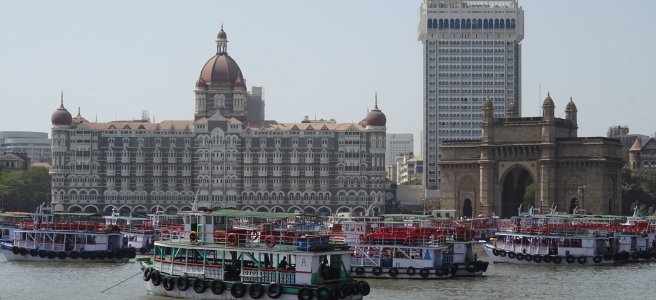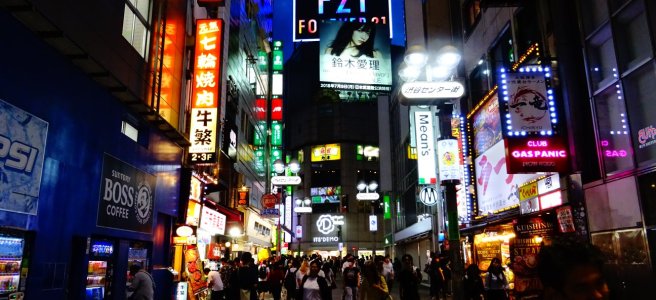A city of lights, where dreams are made and broken. This is where thousands from across the country flock to pursue their big-screen aspirations, a financial powerhouse, home to the rich and famous. But this isn’t LA, this is Mumbai. Even before the symbolic Gateway was finished in 1924 Mumbai was, and still is, a vital aperture to the rest of India. Many a traveller’s journey through the sub-continent still starts here.
However, Mumbai has a reputation as somewhere difficult to traverse and that is generally terrifying. When you tell people where you’re going on holiday you might get a sympathetic “oh, how lovely,” when what they really mean to say is, “another poor soul rammed into the black hole of Bombay, I can’t think of anything worse.”
Mumbai is definitely a place that can test even seasoned travellers. To start with it’s a densely populated metropolis. Estimated at over 20 million people it’s India’s most populous city and that number is only growing. Rush hour on the metro is enough to set off any claustraphobic’s anxiety. Then there’s the traffic, which is chaotic at best and doesn’t seem to follow any semblance of rules other than try not to kill anyone. Just crossing the road can be an ordeal.
There are beggars that will yank at your heart strings. Mother’s sitting on the roadside gesturing for food while carrying malnourished infants, people hauling themselves along on wheeled carts with withered legs tucked uselessly under them. There are all manner of disfigurements on display and in general the impoverished, the down-and-out and the low caste.
Questions of safety arise as well, there are pickpockets ready to steal cameras, wallets and passports, leaving you stranded. Female travellers especially might receive unwanted male attention and even be the victim of sexual attacks not just coming from strangers on the street but from hotel and hostel workers as well. On top of this is the worry of health, with food that might you sick and water reportedly unsafe to drink.
With all this to consider you might be asking yourself, why the hell would I want to expose myself to this place? Mumbai is certainly a place that can assault the senses and give you a good cultural slap in the face. But a lot of these problems are either over-hyped or can be overcome with a bit of preparation, a sense of adventure and the right mentality. Here is my advise for surviving your first 48 hours in Mumbai.
Be prepared for a shock. Nothing can truly prepare you for the sensory bombardment that is Bombay, that’s just part of the package, but you can prepare for eventualities before you go. Make sure to pack rehydration powder or tablets, these will be useful if you get Delhi Belly at any point in your trip or if you’re desperately hungover in Goa. These treatments contain the electrolytes and salts your body loses when you have diarrhoea and will help you recover quicker if you do get sick. Go to your GP or local clinic to find out what injections you might need, they can also supply you with anti-malarial tablets but whether or not you want to take those is a whole other article.
Hand sanitiser is a something you’ll want to take with you. Mumbai has a host of western toilets but there are still a lot of squat toilets and you may well be faced with using a spray-hose or jug of water as toilet paper is something of a luxury at times. Either way there aren’t many that have soap to wash your hands with after and the water may not the cleanest either.
Grabbing a large, secure padlock is a good idea, this will be useful to seal your room or locker if you’re at a lower end hotel or a hostel as other guests and even staff might forage through your possessions and will further secure your bag on trains and buses should you use them on your onward journey. In regards to water it’s a good idea to stick to bottled and not drink what comes out of the tap.
Book ahead, this might seem self-evident but there are those cavalier travellers who like to arrive and see where they end up. There is a certain romantic abandon in trusting to chance but on arriving in Mumbai for the first time it helps to have somewhere to go to when you arrive. Online reviews are your friend, a bit of research can help you turn up whether the staff are professional towards their guests and can set your mind at ease especially if you’re a solo female traveller. It’s nice having somewhere safe and relaxed to retreat to after a hectic day.
Navigating any new city can be problematic and Mumbai, with its labyrinthine streets and roads, is no exception. There are a couple of ways you can easily navigate your way around. The first is a very useful app called MAPS.ME. This app works via GPS and doesn’t need to be connected to Wi-Fi to work, you simply download the app at home and then the map you want to use while you’re away. I have found this app incredibly helpful in a number of countries. It’s not great with public transport and metro services but it’s brilliant for street navigation. Whether you’re on foot or trying to guide a taxi to your destination it cuts right through language barriers and gives you a clear idea of where you are, where you’re going and how to get there.
Once you arrive at the airport head for the prepaid taxi stand, this will get you where you want to go. You might have to ask for directions because it doesn’t stand out and isn’t all that well sign posted. Ignore any other taxi’s trying to grab your attention because they’ll give you an over priced fare and might take you on the “scenic” route via a friend’s shop. There might be a guy who takes your bags for you to put them in the car which might be helpful but he’s doing it expecting a tip. It’s a bit of a rip off, especially if you’ve just landed and might only have big notes to give (which some people count on). Personally I’ll put my own bags in the car just to avoid the situation but if you don’t feel like hauling your bag after a long flight go for it, 50-100 Rs is plenty enough for a tip. Don’t worry if they start tying your bags to the top of the taxi, they’re not going anywhere.
Now you’ll leave the relative safety of the airport and get thrown into Mumbai.. The further into the city you go the more hectic it gets, on the road you will see bull carts, taxis, luxury SUV’s, mopeds, bicycles, wagons, auto-rickshaws, tuk-tuks, pretty much any conceivable mode of transport used since 1500 AD. And that’s failing to mention there are dogs, monkeys and cows freely roaming the streets.
The laws of the road are treated merely as suggestions (although on my last trip I noticed most people stopped for red lights). Taxis do have a habit of making unannounced stops on their way to your destination. This can be particularly unnerving at 4AM when you’re jet lagged, have no clue where you are or why your down a shifty looking back ally. You are not being kidnapped, your driver is probably just grabbing cigarettes, a cup of chai or saying hello to a friend you happen to be passing. Strap in if your seat belt works and enjoy the ride.
If you want to be near the main attractions of Mumbai then the best places to stay are in Fort and Colaba. Here you’ll be a short drive away from Elephanta Island, Leopolds, the Taj Hotel, The Gateway To India and Chhatrapati Shivaji Maharaj Terminus as well as other landmarks in the city. Navigating your way from place to place can be a bit daunting to a new comer. There’s the language barrier to deal with, a lot of drivers have a grasp of basic English but you shouldn’t expect nor rely on this.
Main attractions are easy to get to but finding your way back may present an issue. This is where MAP.ME would come in useful. As for the fare you might get ripped off a little bit. Learning fair prices and how to haggle is all part of the learning curve in India. Typically I suggest aiming to get the price down to at least half or even a third of the first price offered. It’s important, I think, not to get angry or to be rude while doing this. Think of it as a game, sometimes you win, sometimes you lose. Haggling is a must if you really want an authentic experience, barter economy is very much a part of the fabric of many Indians’ daily routine and it’ll be good practice for the rest of your trip if you start here.
There is something charming about not knowing where you are in a new city and finding your own way. However, if you don’t want to spend that time trying to find you way around and don’t want to be constantly haggling there are ways around this problem. Uber and Ola (India’s version of Uber) now operate in most major cities. These not only give you the local price for a fare but also cut out any confusion about getting to your destination. I’m not exaggerating when I say these apps are an absolute god-send when it comes to getting about.
Using these apps breeds another problem though; how do I connect to them? Roaming charges on your phone while abroad can be drastically high, that’s if you can connect to the internet in the first place. One way around this is to get an Indian sim-card for your phone, you can always pre-order one before you go, or, failing this you can always ask the receptionist at you hotel/hostel, they usually “know a guy” who can sort you out with one clandestinely. Alternatively look out for Airtel and Vodafone shops, these are the best and most widely connected providers in India. To obtain a sim-card from an official vendor you’ll need a copy of your passport, visa, your current address in India with proof you are staying there and your home address. Even then some simply don’t sell to tourists (this is to do with the way terrorist and rebel organisations have used disposable sims to organise attacks in the past).
The best way to get a sim is to be organised and get one before you go, you can get one from a street vendor, you’ll notice plenty of unofficial Airtel and Vodafone stalls scattered around. This can save you time and effort of getting one properly but then you run the risk of falling foul of rouge sellers and finding your card expires long before your trip does (but then you can always get another). This option could also land you in trouble with the police so it’s not an option I’d highly recommend but it is possible, just be sure to dispose of your card properly before leaving the country.
You can survive without a sim-card altogether if you don’t mind being out of touch on the move. You’d be wrong to think you’re stepping into a communications black hole when landing in Mumbai. India is an IT giant and over the last ten years infrastructure for better and faster internet connectivity has rapidly linked the country. Mumbai is at the forefront of this, the days of searching for an internet cafe all but consigned to history. Here you can find decent to excellent connections at most hotels and hostels, shopping centres, cafes and restaurants. So not getting a sim-card isn’t the end of the world. Getting an Uber or Ola from you hostel or hotel is simple, getting back might prove a bit more difficult if you can’t find Wi-Fi but at least then you could use MAPS.ME and have a good idea of a fair price for getting back.
Street food is something I’d recommend trying. Where ever you are this way of eating out has a way of directly to the heart of a culture and India is no exception with it’s rich culinary heritage. Here all you really need to do is apply common sense, go to a vendor and ask for something you’ve just seen being freshly cooked if you’re uncertain. Avoid anything that looks like it may have been sat around for a while in the heat and attracting flies.
When it comes to beggars that’s really up to you how you handle it. There are some who will just break your heart, especially the children. If you’re in India for a while it is something you have to steel yourself to and have to accept that you can’t help everyone. I had a rule of limiting myself to helping one person a day, whether that was buying them some food or just giving them some money. There are those who will try to take advantage by playing on the heartstrings feeding you some sob story but you really just have to go with your gut on this one.
Be cautious who’s around if you are going to hand over money, if other beggars spot you doing this they might think you’re a soft touch and come begging to you. Some may even go as far as to follow you, grilling you until you fork over some cash. Don’t. Just keep walking and ignore them, some are more persistent than others but eventually they will leave you alone. For these sometimes it’s a good idea to step into a cafe or restaurant for a cup of chai, they wont follow you inside.
For the safety of female travellers many believe it better to travel with a friend but I have met plenty of solo female travellers in India. The advice they have passed on is being aware of your surroundings, using common sense and going with you gut feeling. If someone makes you feel uncomfortable or is making unwanted advances make an excuse and leave. I’ve known many who have taken to wearing fake wedding rings as a deterrent. A stern no is sometimes all it takes, if all else fails make some noise, cause a scene, draw attention to the fact if you’re receiving unwanted attention. Going out at night alone is not overly advised but stick to busy roads if you do. If you’re alone and find it too stressful then befriend some fellow travellers, even if it’s for a few hours. There is safety in numbers. Though there may be those with some patriarchal throw backs in the city, Mumbai is very modern and considered one of, if not the, safest cities for female travellers in the subcontinent. This being said some caution is still needed.
As for personal belongings again use caution and common sense. When I’ve visited India I’ve always gone with something like a money belt or bum bag. This is where it’s best to keep your passport, money and card so that it’s always on your person either hidden away or in your line of sight. Try to keep valuables out of your pockets because thieves and even monkeys have their ways of getting in there without you noticing, especially in busy crowds. If you happen to be carrying a DSLR camera for that perfect shot you are advertising it to people looking for a five finger discount. Ensure you keep it by you at all times, even if you’re sat at cafe and make sure you have it securely strapped to you in the street else you might lose an expensive toy and worse still some brilliant pictures that you’ll treasure later on.
Mumbai is often described as being an assault on the senses and this is absolutely right. The vibrant colours, the cacophony of sounds, the smells both pungent and glorious, they all come at you unapologetically. But this is what makes Mumbai worth visiting, not a reason to stay away. Mumbai is like a hot bath, you can either dip your toe in and decide its too much or throw yourself in and find yourself surprised how quickly you adjust. This is a multicultural city at the forefront of a rising economic giant, with cultural, architectural and culinary heritage dating back centuries, where religions, languages and ceremonies of days gone by cohabit seamlessly with the modern age. So keep your wallet close, your eyes open, your heart strings primed and delve into Mumbai.




